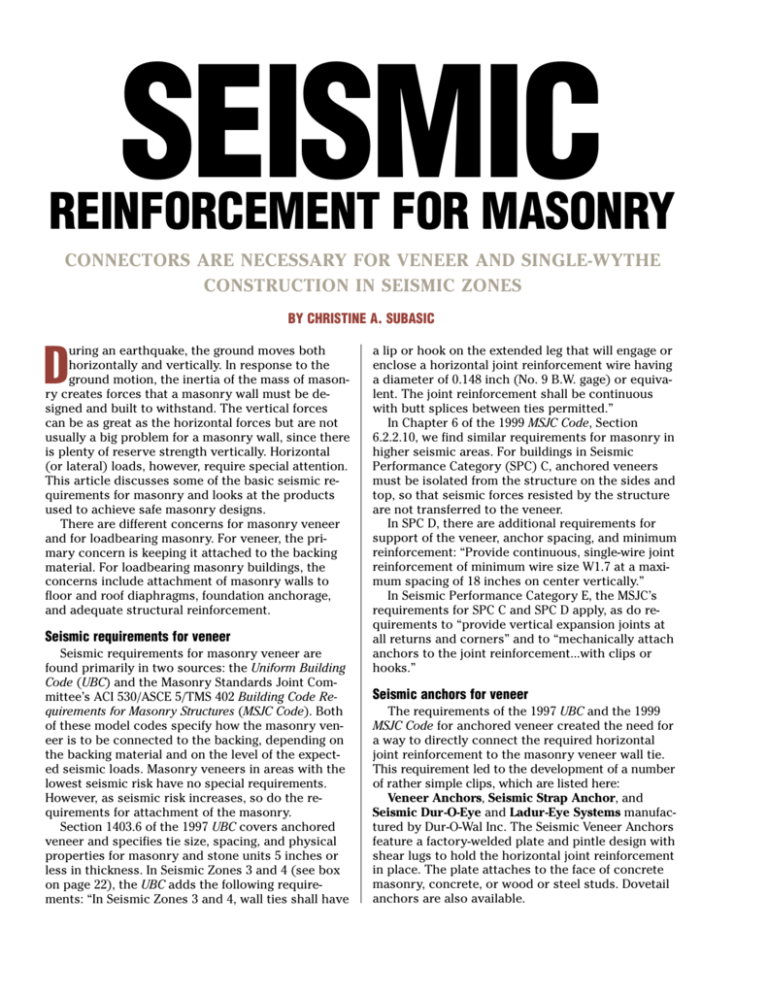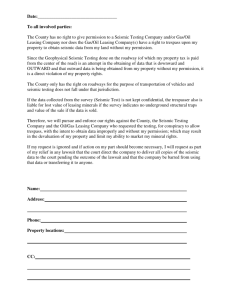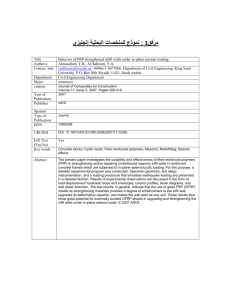
SEISMIC
REINFORCEMENT FOR MASONRY
CONNECTORS ARE NECESSARY FOR VENEER AND SINGLE-WYTHE
CONSTRUCTION IN SEISMIC ZONES
BY CHRISTINE A. SUBASIC
uring an earthquake, the ground moves both
horizontally and vertically. In response to the
ground motion, the inertia of the mass of masonry creates forces that a masonry wall must be designed and built to withstand. The vertical forces
can be as great as the horizontal forces but are not
usually a big problem for a masonry wall, since there
is plenty of reserve strength vertically. Horizontal
(or lateral) loads, however, require special attention.
This article discusses some of the basic seismic requirements for masonry and looks at the products
used to achieve safe masonry designs.
There are different concerns for masonry veneer
and for loadbearing masonry. For veneer, the primary concern is keeping it attached to the backing
material. For loadbearing masonry buildings, the
concerns include attachment of masonry walls to
floor and roof diaphragms, foundation anchorage,
and adequate structural reinforcement.
D
Seismic requirements for veneer
Seismic requirements for masonry veneer are
found primarily in two sources: the Uniform Building
Code (UBC) and the Masonry Standards Joint Committee’s ACI 530/ASCE 5/TMS 402 Building Code Requirements for Masonry Structures (MSJC Code). Both
of these model codes specify how the masonry veneer is to be connected to the backing, depending on
the backing material and on the level of the expected seismic loads. Masonry veneers in areas with the
lowest seismic risk have no special requirements.
However, as seismic risk increases, so do the requirements for attachment of the masonry.
Section 1403.6 of the 1997 UBC covers anchored
veneer and specifies tie size, spacing, and physical
properties for masonry and stone units 5 inches or
less in thickness. In Seismic Zones 3 and 4 (see box
on page 22), the UBC adds the following requirements: “In Seismic Zones 3 and 4, wall ties shall have
a lip or hook on the extended leg that will engage or
enclose a horizontal joint reinforcement wire having
a diameter of 0.148 inch (No. 9 B.W. gage) or equivalent. The joint reinforcement shall be continuous
with butt splices between ties permitted.”
In Chapter 6 of the 1999 MSJC Code, Section
6.2.2.10, we find similar requirements for masonry in
higher seismic areas. For buildings in Seismic
Performance Category (SPC) C, anchored veneers
must be isolated from the structure on the sides and
top, so that seismic forces resisted by the structure
are not transferred to the veneer.
In SPC D, there are additional requirements for
support of the veneer, anchor spacing, and minimum
reinforcement: “Provide continuous, single-wire joint
reinforcement of minimum wire size W1.7 at a maximum spacing of 18 inches on center vertically.”
In Seismic Performance Category E, the MSJC’s
requirements for SPC C and SPC D apply, as do requirements to “provide vertical expansion joints at
all returns and corners” and to “mechanically attach
anchors to the joint reinforcement...with clips or
hooks.”
Seismic anchors for veneer
The requirements of the 1997 UBC and the 1999
MSJC Code for anchored veneer created the need for
a way to directly connect the required horizontal
joint reinforcement to the masonry veneer wall tie.
This requirement led to the development of a number
of rather simple clips, which are listed here:
Veneer Anchors, Seismic Strap Anchor, and
Seismic Dur-O-Eye and Ladur-Eye Systems manufactured by Dur-O-Wal Inc. The Seismic Veneer Anchors
feature a factory-welded plate and pintle design with
shear lugs to hold the horizontal joint reinforcement
in place. The plate attaches to the face of concrete
masonry, concrete, or wood or steel studs. Dovetail
anchors are also available.
Hohmann & Barnard Inc.
Fig. 1: Either the No. 370 Seismic Hook Tab or the Seismic
Tab Notch will work with any of Heckmann’s veneer anchors
SEISMICLIP Interlock System, Seismic-Notch
Anchors, and T-LOK TIE, manufactured by Hohmann
& Barnard. The SEISMICLIP is a rigid extruded PVC
clip with multiple retaining ridges for snapping in
the continuous joint reinforcement and Hohmann &
Barnard’s wire tie products (Fig. 2). It is available in
two sizes: one designed for a 3⁄ 16 - inch wire tie and
one designed for a 1⁄4 - inch wire tie. Both sizes accept
either 9-gage or 3⁄ 16 - inch - diameter horizontal joint
reinforcement. Hohmann & Barnard recommends
first installing the required wire ties, then attaching
the SEISMICLIP on a dry brick course. The continuous joint reinforcement is then snapped into place,
and mortar is spread over the entire bed.
Seismic-Notch Anchors are flat anchors used to
connect masonry veneer with concrete, masonry, or
stud backup systems. There are three options,
including dovetail, L-shaped, and the Gripstay
anchors, depending on the material of the backup
wall. All have the Seismic-Notch that forms a seat to
accommodate 9-gage or 3⁄ 16 - inch - diameter continuous wire.
Masonry Reinforcing Corp. of America
Heckman Building Products
The Seismic Strap Anchor is an L-shaped
adjustable corrugated veneer anchor with two shear
lugs to engage horizontal joint reinforcement. It is
attached to the face of the backup system.
Dur-O-Eye and Ladur-Eye are used to tie two
masonry wythes together. They feature a factorywelded pintle plate with shear lugs to hold the horizontal joint reinforcement in place.
Fig. 2: The SEISMICLIP is a rigid extruded PVC clip that
works with either 3⁄16- or 1⁄4-inch wire ties.
Seismic Tab Notch and No. 370 Seismic Hook
Tab, manufactured by Heckmann Building Products.
The Seismic Tab Notch is available for any of the flat
anchors manufactured by Heckmann, including Ltype veneer anchors for attaching to the surface of
the backing and dovetail anchors for attaching to
cast-in slots in concrete backing (Fig. 1). The
Seismic Tab Notch is attached to the backup structure, then laid on a bed of mortar. The horizontal
joint reinforcement is then snapped into the notch,
and more mortar is spread on top.
The No. 370 Seismic Hook Tab is a bent metal
plate with a hook for engaging horizontal joint reinforcement. It can be factory-welded to triangular
ties, double pintle wire ties, or any 3⁄16-inch- or 1⁄4inch-diameter wire tie. The tie with the welded tab
is attached to the backup structure, then laid in a
bed of mortar. Joint reinforcement is then placed in
the hook, and mortar is spread on top.
Fig. 3: After you position the WIRE-BOND Clip on the dry
brick, mortar is spread on top.
An adaptation of the Seismic Notch is the T-LOK
TIE, a two-piece flat anchor system. One of the Lshaped pieces is attached to the backup system and
has a slot in the horizontal leg. The second fits
through the slot in the first and has a Seismic-Notch
for insertion of a continuous reinforcing wire.
WIRE-BOND Clip, manufactured by Masonry
Reinforcing Corp. of America. A small bent metal
plate that is factory-welded to any of the firm’s double-hook wire ties, it has a hook to engage the horizontal joint reinforcement. The WIRE-BOND Clip can
be used with truss-type ties with double pintle legs,
with dovetail triangular ties, and with metal stud
wire anchors (Fig. 3). The ties with the welded clip
are installed first, dry on the brick. The horizontal
joint reinforcement is then clipped into place.
WHAT IS A SEISMIC PERFORMANCE CATEGORY?
istorically, the seismic loads a building was
designed to withstand were based on where the
building was to be built. The three model code
groups published maps that divided the United
States into Seismic Zones 0 through 4. Seismic
Zone 0, an area with virtually no possibility of an
earthquake, was assigned very low seismic design
forces. Seismic Zones 1 through 4 were assigned
progressively higher design forces, with Seismic
Zone 4 indicating an area with a high probability of
strong earthquakes. To design a building, the
designer took the location of the building site,
found the seismic zone, and calculated the corresponding design force.
Beginning in the 1970s, the Federal Emergency
Management Agency (FEMA), instituted the
National Earthquake Hazard Reduction Program
(NEHRP, pronounced “nee-herp”). Under that program, teams of designers, researchers, and building officials developed a new system that has been
incorporated into the UBC and the MSJC Code (and
by reference into the BOCA National Building Code
and the Southern Building Code Congress
International’s Standard Building Code) and is
therefore the law in most of the United States.
Under the new system, a given building is
assigned a Seismic Performance Category, based
on a combination of its geographical location
(roughly the same as the old Seismic Zones), and
how “essential” the building is (the Seismic Hazard
Exposure Group). As Seismic Performance
Categories go from A through E, the building must
be designed for increasingly higher loads and
more stringent requirements for placement and
detailing of reinforcement. Under this system, for
example, a typical office building might have to be
designed based on the requirements for SPC B,
while an adjacent “essential” facility (such as a
hospital or police station) would have to be
H
Fleming Masonry Anchoring System, manufactured by Halfen Anchoring Systems and represented exclusively in the United States by MeadowBurke Products. This system has three elements:
anchor slots secured to the backup structure, anchors connecting the slot and the masonry wythe,
and a single horizontal joint reinforcing wire
(Fig. 4). The anchor slot channels can be attached
to wood or metal stud backup structures. The
Fleming Anchors are then inserted into the channel
slots, and the horizontal wire is hooked under the
tabs on the anchor. Mortar is then spread on the
entire bed.
designed based on the higher forces and more
stringent detailing requirements of SPC C.
Unfortunately, the old Seismic Zone maps and the
new NEHRP map don’t match up exactly, so a former Zone 2, for example, doesn’t necessarily correspond to SPC C, even for the same type of building.
As if all this weren’t complicated enough,
NEHRP has recently proposed a slight modification
of what they call Seismic Design Categories. To
determine a building’s SDC, the designer must
check the more severe of two seismic zoning
maps, then consider the type of soil at the building
site and how essential the building is. The new
International Building Code (IBC 2000) incorporates
these Seismic Design Categories. The new soil
requirements are intended to recognize that buildings on more flexible soils (such as deep clay as
opposed to rock or sand) will experience higher
seismic loads.
In practice, what this means is that either the
building official will dictate the SDC of a site or a
geotechnical engineer will have to evaluate the
soil. If the designer doesn’t want to go to the
expense of a soil test to determine what the soil
class is, then he or she must assume a poor soil,
which automatically increases the seismic design
requirements. Building owners will now have to
weigh the cost of a geotechnical investigation
against the increased cost of the building if a poor
soil is assumed.
Although previous codes also increased
required seismic design forces for buildings on
poor soil, the new IBC 2000 actually moves such
buildings into a more severe SDC, which can increase the prescriptive requirements for the design method, reinforcement, materials, and construction. This can have a significant effect on the
cost of a masonry building.
SCP -“QUAKE -TIE,” manufactured by Southern
Construction Products. This small sheet metal plate
is factory-welded to the tie’s wire pintles or triangles
and has a hook to engage the horizontal joint reinforcement (Fig. 5). Southern Construction Products
recommends that the SPC-“Quake-Tie” be laid on a
wet mortar bed, then the horizontal joint reinforcement clipped into place and the next course of brick
laid directly on top.
Seismic requirements for loadbearing masonry
Model building codes contain many special requirements for structural, or loadbearing, mason-
Meadow Burke Products/Halfen Anchoring Systems
Metal or
wood stud
back-up
Fleming
Anchor
Slot
Fleming
Anchor
Exterior
sheathing
Reinforcing
wire
Southern Construction Products Inc.
Fig. 4: The Fleming Masonry Anchoring System works with
wood or metal stud backings.
Fig. 5: The SCP-“QUAKE-TIE” is welded to a wire tie and
hooks under the joint reinforcement.
ry built to withstand seismic forces. Both the UBC
and the MSJC Code dictate minimum reinforcement and address the strength required for the
connection of masonry walls to other building elements.
In the lowest seismic risk areas (SPC A/Seismic
Zones 0 and 1), the anchorage of masonry walls is
the primary concern of both codes. The MSJC Code
requires that “masonry walls be anchored to the
roof and all floors that provide lateral support,” and
specifies the amount of lateral force that these connections must resist. In SPC B, the 1999 MSJC Code
prohibits the use of empirical design for the lateralforce-resisting system.
The 1997 UBC also contains requirements for different types of anchorage. Section 1633.2.8 states
that “in Seismic Zones 3 and 4, diaphragm to wall
anchorage using embedded straps shall have the
straps attached to or hooked around the reinforcing
steel or otherwise terminated to effectively transfer
forces to the reinforcing steel.” Where wood
diaphragms are used to laterally support masonry
walls, further restrictions are placed on the anchorage, such as prohibiting the use of toenails or nails
subject to withdrawal.
As seismic risk increases, the requirements for
loadbearing masonry expand to include minimum
reinforcement requirements that increase for each
level of seismic risk. The force that masonry-todiaphragm connectors are designed to resist also
increases. Because of their complexity and loaddependent nature, reinforcement requirements are
not given here. Instead, this article focuses on the
products that are used to transfer the seismic
forces. See the appropriate sections of the model
codes for specific design requirements.
The ways to anchor masonry walls to
floors, roofs, and steel columns and beams
are almost limitless. The products shown
here represent only a sampling of what is
available, particularly the straps and
anchors used in low seismic risk areas.
Specialized products are highlighted.
Southern Construction Products Inc.
Anchors for loadbearing masonry
Fig. 6: Ties are available from several manufacturers to anchor
a masonry wall to structural steel.
Masonry wall to steel column/beam—The
tie manufacturers have developed both strap anchors and wire ties that are designed to hook around
the flange of a steel column or beam. Wire ties are
typically embedded into the masonry mortar joint.
Flat strap anchors may be corrugated and embedded
into a mortar joint, or they may have a hook that extends into a grouted cell. Anchor strength is an important criterion in selection of anchor type in areas
of higher seismic risk. Typically, strap anchors are
more suitable for higher seismic loads. Fig. 6 shows
samples of some of the anchors readily available.
Manufacturers include: Dur-O-Wal, Heckmann Building
Meadow Burke Product/Halfen Anchoring Systems
Rebar reinforcing
in block wall
Custom restraint
strap with clearance
hole to suit rebar
Halfen anchor channel
cast into edge of concrete
beam
Custom restraint
with bent end
Fig. 7: Some anchors are designed to engage the horizontal
or vertical reinforcing steel.
Products, Hohmann & Barnard, Masonry Reinforcing
Corp. of America, Meadow Burke/Halfen, and
Southern Construction Products.
Masonry wall to concrete or masonry wall/column—
For this connection, generally a flat anchor with a
channel slot receiver or a flat anchor with hooks at
each end is used. The anchor may be corrugated.
Manufacturers include: Dur-O-Wal, Heckmann
Building Products, Hohmann & Barnard, Masonry
Reinforcing Corporation, Meadow Burke/Halfen,
Simpson Strong-Tie, and Southern Construction
Products.
Masonry wall to floor/roof diaphragm—Many of the
flat strap anchors described above have hooks that
can be used to engage the reinforcing steel as required by Section 1633.2.8 of the 1997 UBC. Custom
strap anchors are also available from a variety of
manufacturers. Figure 7 shows two anchors designed
especially for this use. Manufacturers include
Meadow Burke / Halfen and others.
Reinforcing bar confinement—Designed to meet the
requirements of Section 2108.2.5.6 of the 1994 UBC,
Dur-O-Wal’s Seismic Comb provides vertical reinforcing bar confinement.
Christine A. Subasic, P.E., is a consulting engineer and freelance
writer based in Raleigh, N.C. She previously worked as an engineer
for the Brick Institute of America (now the Brick Industry Association),
Reston, Va. You can search for other articles by this author or on reinforced masonry by visiting www.worldofconcrete.com.
HOW TO CONTACT THE
ANCHOR MANUFACTURERS
Dur-O-Wal/Dayton Superior, Aurora, Ill. (877-8518400 toll free; 630-851-8400); www.dur-o-wal.com.
Heckmann Building Products Inc., Chicago (800621-4140; 773-826-8564); www.heckmannbuildingprods.com.
Hohmann & Barnard Inc., Hauppauge, N.Y. (800645-0616;); www.h-b.com.
Masonry Reinforcing Corp. of America,
Charlotte, N.C. (800-849-6722; 704-525-5554);
www.wirebond.com.
Meadow Burke Products/Halfen Anchoring
Systems, Converse, Texas (800-323-6896; 210-6584671); www.halfenusa.com.
Simpson Strong-Tie Company Inc., Pleasanton,
Calif. (800-999-5099; 925-460-9912);
www.strongtie.com.
Southern Construction Products Inc.,
Birmingham, Ala. (800-821-9296; 205-251-2525);
www.scponline.com.
Publication #M00D020
Copyright© 2000, The Aberdeen Group
a division of Hanley-Wood, Inc.
All rights reserved








